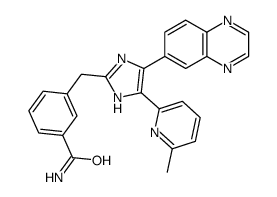868612-83-3
| Name | 3-[[5-(6-methylpyridin-2-yl)-4-quinoxalin-6-yl-1H-imidazol-2-yl]methyl]benzamide |
|---|---|
| Synonyms |
IN-1130
3-((5-(6-methylpyridin-2-yl)-4-(quinoxalin-6-yl)-1(3)H-imidazol-2-yl)methyl)benzamide UNII-KW4O83PQ97 Benzamide,3-((4-(6-methyl-2-pyridinyl)-5-(6-quinoxalinyl)-1H-imidazol-2-yl)methyl) Benzamide,3-((5-(6-methyl-2-pyridinyl)-4-(6-quinoxalinyl)-1H-imidazol-2-yl)methyl) |
| Description | IN-1130 is a highly selective transforming growth factor-β type I receptor kinase (ALK5) inhibitor with an IC50 of 5.3 nM for ALK5-mediated Smad3 phosphorylation. IN-1130 inhibits ALK5 phosphorylation of casein (IC50=36 nM) and p38α mitogen-activated protein kinase (IC50=4.3 μM). IN-1130 suppresses renal fibrosis in obstructive nephropathy and blocks breast cancer lung metastasis[1][2]. |
|---|---|
| Related Catalog | |
| Target |
ALK5 |
| In Vitro | IN-1130 (0.5, 1 μM; for 2 hours) inhibits TGF-β-stimulated Smad2 phosphorylation and subsequent nuclear translocation in HepG2 and 4T1 cells[2]. IN-1130 (1 μM; for 72 hours) restores the TGF-β-mediated decrease in E-cadherin protein expression. IN-1130 (1 μM; for 72 hours) inhibits TGF-β-induced MMPs mRNA expression and the gelatinolytic activity of secreted MMPs in MCF10A cells[2]. IN-1130 (1 μM; pretreated for 30 min) inhibits TGF-β-induced MDA-MB-231 cells, NMuMG, and MCF10A cells mobility and invasion[2]. Western Blot Analysis[2] Cell Line: HepG2 and 4T1 cells Concentration: 0.5, 1 μM Incubation Time: For 2 hours Result: Inhibited TGF-β-stimulated Smad2 phosphorylation. RT-PCR[2] Cell Line: MCF10A cells Concentration: 1 μM Incubation Time: For 72 hours Result: Inhibited TGF-β-induced MMPs mRNA expression and the gelatinolytic activity of secreted MMPs. |
| In Vivo | IN-1130 (10, 20 mg/kg/day; IP; for 7 and 14 days) reduces the extent of interstitial nephritis and fibrosis (arrowheads) with 10 mg/kg and significantly reduces or absent histopathological changes with 20 mg/kg in unilateral ureteral obstruction (UUO) rats[1]. IN-1130 (10, 20 mg/kg/day; for 14 days) dose-dependently decreases levels of TGF-β1 mRNA and suppresses phosphorylation of Smad2, α-SMA, myofibroblasts in rat UUO kidneys[1]. IN-1130 (40 mg/kg; IP; 3 times per week for 3 weeks) inhibits in vivo breast cancer metastasis to the lungs in MMTV/c-Neu mice (Eight-week-old female BALB/c mice)[2]. Animal Model: Six-week-old male Sprague–Dawley rats weighing 180-200 g[1] Dosage: 10 and 20 mg/kg Administration: IP; daily; for 7 and 14 days Result: Reduced the extent of interstitial nephritis and fibrosis (arrowheads) with 10 mg/kg. |
| References |
| Molecular Formula | C25H20N6O |
|---|---|
| Molecular Weight | 420.46600 |
| Exact Mass | 420.17000 |
| PSA | 111.43000 |
| LogP | 4.96420 |
| Storage condition | -20°C |
| Symbol |

GHS07 |
|---|---|
| Signal Word | Warning |
| Hazard Statements | H302 |
| Precautionary Statements | P301 + P312 + P330 |
| RIDADR | NONH for all modes of transport |
